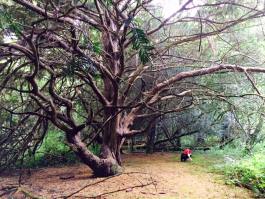This blog post originally appeared on the Woodland Trust News and Blog.
Have you ever stood in a woodland and closed your eyes, even for a few moments? Could you hear the rummaging of the squirrel, smell the familiar pungency of the damp musk that follows the rainfall, or feel the movement of the wind as it danced through the trees?
I have often found myself watching the woodlands, those beautiful, radiant colours that turn and change with the moods of the seasons. Tracing the contours of the twisting limbs which rise towards the sky to finally burst with offshoots of green. But there is so much more to the woodlands than what is seen. So often the beauty of the woodland is a scene to behold with the eyes alone.
The presence of trees
My research has explored how woodlands are perceived and experienced by people who have impaired vision. I walked one-to-one as their sighted guide, wandering the woodlands of the South East for over two years. In this time I learned how people perceived and engaged with woodlands through senses other than sight.
Something that really struck me in this research was how so many of my companions described trees to have a “presence”. Approached as giant, “wise” anthropomorphic beings and acknowledged to have lived for as many or more years than you and I put together. As we arched our necks back and extended our arms to explore the textures of the trunk with confident hands, my companions often described how much of the tree was “out of reach”. Many times our height, the full felt presence of the tree was unknown.
Listening to trees with echolocation
As we stood beneath a tree, in the shadows of the canopy, I was often invited by my companion to listen. The breath of the wind that whistled through the tree revealed the contours and textures of the foliage high above us. The brittle rattle of beech in autumn, with leaves refusing to fall; hearing the creaking boughs of the ancient cedar, revealing its height.
But there were ways of listening to the woodland that was a mystery to me. Echolocation is an activity of listening to the way that sound echoes – how sound bounces off surfaces. Listening to this echo, the way that the woodland became more open or enclosed, thinned and thickened, was audible. The sounds of our footsteps upon the beaten path and the resound of our chattering voices bounced off the trees, revealing their presence.
When it rains, the woodland sings. Each leaf sounds a note in this symphony, and the contours of the body of trees reveals itself. Rain gives a voice to everything that it touches. No tree is out of reach with the fall of rain, and the fullness of its breadth is heard. Dripping leaves sound the heights of trees, water runs down the bark bodies to gather in small pools around exposed roots. One can listen to the expanse of the woodland all around, listening to the form of each tree that is revealed in rain.
Explore your own multi-sensory woodland
I share these brief accounts with you as an invitation, or inquisitive reminder, to listen to the woodlands. To place your hands on the body of the oak, as well as cast your eyes about it. I ask, what are the qualities of a tree – or an entire woodland – that are revealed when we attend with our whole bodies? I hope that you will join me in exploring this question in your own experiences with trees and woodlands.

Karis Jade Petty is now finishing up her PhD in Anthropology at the University of Sussex, which explores the perception of city parks in and around Brighton for people who have impaired vision. Exploring sensory perception, memory, and activities within the parks, she contributes to anthropological approaches to, and understandings of, sensory perception, the environment, ‘placemaking’, temporality, and the body.





Leave a Reply